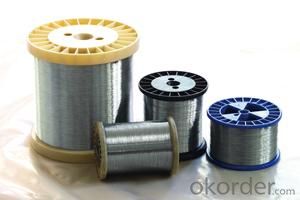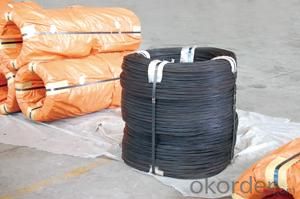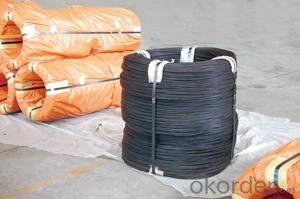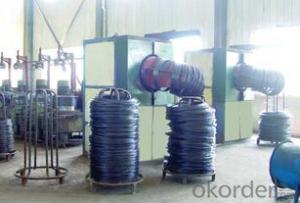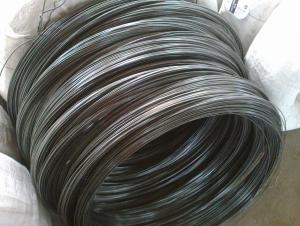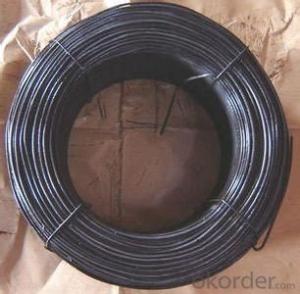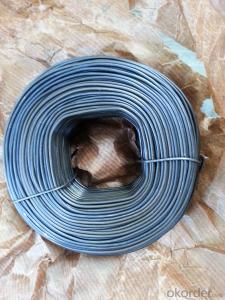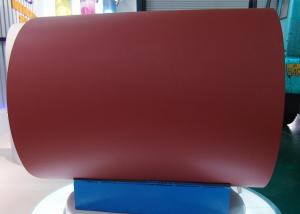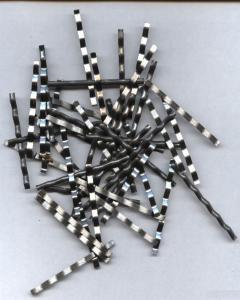BRIGHT ANNEALED WIRE AND BLACK ANNEALED WIRE
- Loading Port:
- China Main Port
- Payment Terms:
- TT OR LC
- Min Order Qty:
- -
- Supply Capability:
- -
OKorder Service Pledge
OKorder Financial Service
You Might Also Like
Packaging & Delivery
| Packaging Detail: | coil, spool, piece, rosset coil, drum, cardboard carton |
| Delivery Detail: | 0-4weeks |
Specifications
annealed wire:
size:0.20mm-5.00mm
material:low carbon steel
shape:bright annealed or black annealed
Application | Weaving, braiding, tie wire in building,parks and daily binding,or for further straightened and cut into cut wire or U type wire |
Material | low carbon steel wire |
Diameter | 0.2mm~5.00mm |
Tensile strength | 350-540MPA, or higher |
Zinc coating | Min 12g/m2, min 25g/m2, min 200g/m2, |
Surface treatment | galvanized or non-galvanized |
Packing | On spools of DIN160, DIN200, DIN250, BB20, MP100 etc. In small coils of 25-50kg/coil, 10kg/coil or even 2-5kg/coil In rosette coil of 100-800kg/coil |
All can be produced according to customers’ actual requirement.
- Q: What are the different types of steel sections used in industrial structures?
- There are several types of steel sections commonly used in industrial structures, including I-beams, H-beams, channels, angles, and T-sections. These sections are chosen based on their structural properties, such as load-bearing capacity and resistance to bending. Each section has its own unique shape and dimensions, allowing for efficient distribution of weight and optimal structural integrity in various applications.
- Q: How is steel pipe threaded for plumbing applications?
- Steel pipe is threaded for plumbing applications using a threading machine or a manual pipe threader. The pipe is clamped securely, and a die is used to cut threads into the pipe's surface. The process ensures a tight and secure connection between pipes, allowing for leak-free plumbing systems.
- Q: How is steel wire rope inspected for fatigue and wear?
- Steel wire rope is inspected for fatigue and wear through a variety of methods. One common approach is visual inspection, where trained personnel examine the rope for any signs of fraying, broken wires, or corrosion. Additionally, non-destructive testing techniques such as magnetic particle inspection or ultrasonic testing can be used to detect internal flaws or defects. Regular load testing is also conducted to evaluate the rope's performance under simulated working conditions. Overall, a combination of visual inspection, non-destructive testing, and load testing ensures a thorough inspection of steel wire rope for fatigue and wear.
- Q: How do steel products contribute to the construction of theaters and concert halls?
- Steel products contribute to the construction of theaters and concert halls in various ways. Firstly, steel is widely used for the structural framework of these buildings, providing strength and support. It allows for large open spaces, accommodating the grand designs and unique architectural features often found in these venues. Additionally, steel is used for the fabrication of trusses, beams, and columns, ensuring stability and durability. Its versatility enables the creation of intricate designs, such as curved or cantilevered structures, enhancing the aesthetic appeal of these cultural spaces. Moreover, steel is a fire-resistant material, providing safety measures to protect both the building and its occupants. Overall, steel products play a vital role in constructing theaters and concert halls, facilitating their artistic and functional requirements.
- Q: How is steel used in the production of textile machinery?
- Steel is used in the production of textile machinery due to its strength, durability, and ability to withstand high temperatures. It is commonly used in the construction of machine frames, gears, and other mechanical components that require stability and precision. Additionally, steel is often used in the manufacturing of textile machine parts that need to be resistant to wear and tear, ensuring the longevity and reliability of the machinery.
- Q: What are the different types of steel bars used in construction?
- There are several types of steel bars commonly used in construction, including mild steel bars, deformed steel bars, high-strength deformed steel bars, and epoxy-coated steel bars. Each type has specific properties and uses, but they all provide strength and reinforcement to various structural elements in buildings and other construction projects.
- Q: What are the different types of steel channels?
- There are several different types of steel channels, including C channels, U channels, and J channels. C channels have a distinct shape resembling the letter C and are often used in structural applications. U channels have a shape resembling the letter U and are commonly used for edge protection or as a support beam. J channels have a shape resembling the letter J and are typically used for framing window and door openings.
- Q: How are steel products used in the food processing industry?
- Steel products are widely used in the food processing industry for a variety of applications. They are used to manufacture machinery and equipment such as mixers, conveyors, and cutting tools, which are essential for processing, packaging, and storing food products. Steel is preferred due to its durability, resistance to corrosion, and ability to withstand high temperatures and harsh conditions. Additionally, stainless steel, a type of steel that contains chromium and nickel, is commonly used for food contact surfaces, storage tanks, and utensils as it is hygienic, easy to clean, and prevents contamination. Overall, steel products play a crucial role in maintaining food safety, efficiency, and quality in the food processing industry.
- Q: What are the properties of galvanized steel for outdoor applications?
- Galvanized steel is highly suitable for outdoor applications due to its exceptional properties. It possesses a protective zinc coating that prevents corrosion and rusting, ensuring durability and longevity even in harsh weather conditions. Additionally, galvanized steel exhibits excellent resistance against damage from UV rays, moisture, and various environmental factors, making it ideal for outdoor structures, fences, roofing, and other applications requiring reliable and long-lasting performance.
- Q: What are the different types of steel meshes and their applications?
- There are several different types of steel meshes with various applications. Some common types include welded wire mesh, expanded metal mesh, and woven wire mesh. Welded wire mesh is frequently used in construction, agriculture, and fencing due to its strength and durability. Expanded metal mesh is often utilized for grating, walkways, and filters due to its high load-bearing capacity and ventilation properties. Woven wire mesh is commonly used in industries such as mining, filtration, and security due to its versatility and ability to withstand heavy-duty applications. Overall, steel meshes serve diverse purposes and are chosen based on their specific properties and intended applications.
Send your message to us
BRIGHT ANNEALED WIRE AND BLACK ANNEALED WIRE
- Loading Port:
- China Main Port
- Payment Terms:
- TT OR LC
- Min Order Qty:
- -
- Supply Capability:
- -
OKorder Service Pledge
OKorder Financial Service
Similar products
Hot products
Hot Searches
Related keywords


